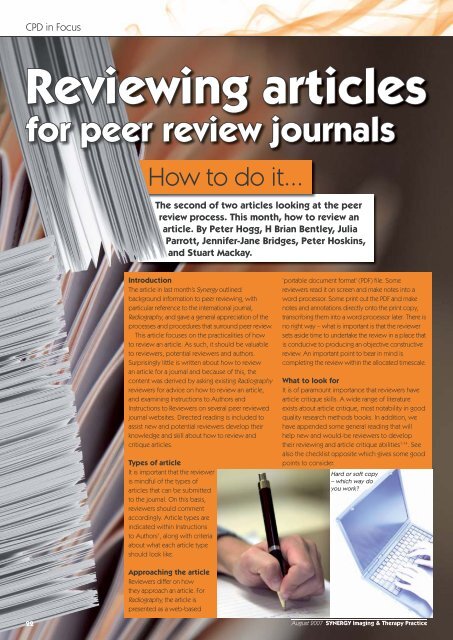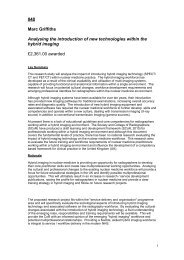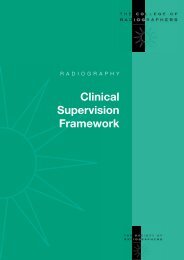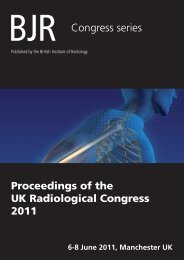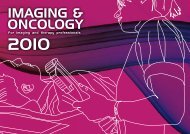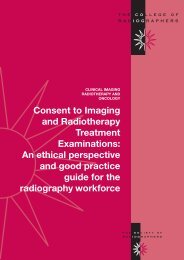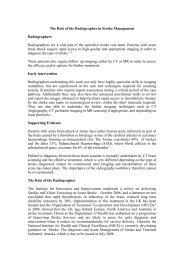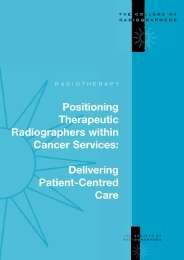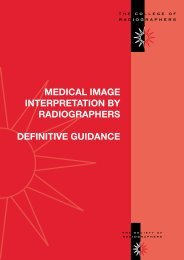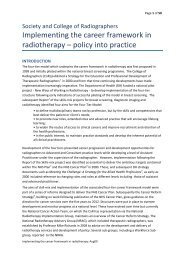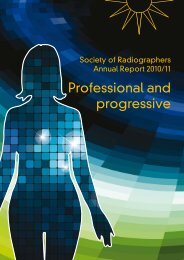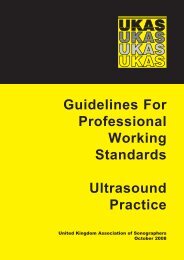You also want an ePaper? Increase the reach of your titles
YUMPU automatically turns print PDFs into web optimized ePapers that Google loves.
CPD in Focus<br />
<strong>Reviewing</strong> <strong>articles</strong><br />
for peer review journals<br />
How to do it...<br />
The second of two <strong>articles</strong> looking at the peer<br />
review process. This month, how to review an<br />
article. By Peter Hogg, H Brian Bentley, Julia<br />
Parrott, Jennifer-Jane Bridges, Peter Hoskins,<br />
and Stuart Mackay.<br />
Introduction<br />
The article in last month’s Synergy outlined<br />
background information to peer reviewing, with<br />
particular reference to the international journal,<br />
Radiography, and gave a general appreciation of the<br />
processes and procedures that surround peer review.<br />
This article focuses on the practicalities of how<br />
to review an article. As such, it should be valuable<br />
to reviewers, potential reviewers and authors.<br />
Surprisingly little is written about how to review<br />
an article for a journal and because of this, the<br />
content was derived by asking existing Radiography<br />
reviewers for advice on how to review an article,<br />
and examining Instructions to Authors and<br />
Instructions to Reviewers on several peer reviewed<br />
journal websites. Directed reading is included to<br />
assist new and potential reviewers develop their<br />
knowledge and skill about how to review and<br />
critique <strong>articles</strong>.<br />
Types of article<br />
It is important that the reviewer<br />
is mindful of the types of<br />
<strong>articles</strong> that can be submitted<br />
to the journal. On this basis,<br />
reviewers should comment<br />
accordingly. Article types are<br />
indicated within Instructions<br />
to Authors 1 , along with criteria<br />
about what each article type<br />
should look like.<br />
‘portable document format’ (PDF) file. Some<br />
reviewers read it on screen and make notes into a<br />
word processor. Some print out the PDF and make<br />
notes and annotations directly onto the print copy,<br />
transcribing them into a word processor later. There is<br />
no right way – what is important is that the reviewer<br />
sets aside time to undertake the review in a place that<br />
is conducive to producing an objective constructive<br />
review. An important point to bear in mind is<br />
completing the review within the allocated timescale.<br />
What to look for<br />
It is of paramount importance that reviewers have<br />
article critique skills. A wide range of literature<br />
exists about article critique, most notability in good<br />
quality research methods books. In addition, we<br />
have appended some general reading that will<br />
help new and would-be reviewers to develop<br />
their reviewing and article critique abilities 1-14 . See<br />
also the checklist opposite which gives some good<br />
points to consider.<br />
Hard or soft copy<br />
– which way do<br />
you work?<br />
Approaching the article<br />
Reviewers differ on how<br />
they approach an article. For<br />
Radiography, the article is<br />
presented as a web-based<br />
22 August 2007 SYNERGY Imaging & Therapy Practice
CPD in Focus<br />
When reviewing the article, consideration should be paid to the<br />
following:<br />
1. English: this is important but not critical, because defi ciencies can<br />
be improved. Obviously, there is a point beyond which the article is<br />
unintelligible and, as such, the reviewer would have no option but<br />
to reject it. The key thing is to look beyond the standard of English<br />
and ask fundamental questions about the science and content of the<br />
work. That said, it is not uncommon to indicate that the article needs<br />
to be edited for English. Please note that Radiography does not offer<br />
a service to edit <strong>articles</strong> for authors and as such the responsibility lies<br />
with the author.<br />
Factors like grammar, spelling, typographical errors, sentence and<br />
paragraph construction should be assessed and commented upon.<br />
Given that Radiography is an international peer reviewed journal (more<br />
than 50% of submitted <strong>articles</strong> are international), it is not unusual<br />
for the author’s fi rst language not to be English, and at times this can<br />
be spotted easily. If this is the case, consider suggesting that the<br />
author seeks help from a professional or a colleague who has a good<br />
command of the English language. It is also worth noting that, at a<br />
recent Editorial Board, it was agreed that American-English and also<br />
‘Standard’ English are acceptable. This is consistent with most other<br />
international journals that are British in origin.<br />
2. Structure: no matter what type of article, there should be a logical<br />
structure. Additionally, for certain article types, a specifi c structure<br />
may be indicated in the Instructions to Authors and this should be<br />
adhered to.<br />
Various factors should be taken into account when assessing<br />
structure. For example arguments should be logical, organised and<br />
coherent, building from a general position and then focusing into the<br />
key issues. Repetition should be avoided. Sub-sections should be<br />
consistent with what is expected – for example, the abstract should<br />
refl ect concisely the article and as such provide a clear window into<br />
it. Similarly, if the article type has results, these should be clearly set<br />
out in a fashion that is easy to follow.<br />
3. Content: the reviewer should consider whether the article adds<br />
to the existing body of knowledge and also whether it fi ts within the<br />
aims and scope of the journal. Alongside this, the rationale for the<br />
paper should be assessed.<br />
If the article requires the use of a method, its validity and reliability<br />
should be considered and if necessary commented upon – it should<br />
be described in such a way that it can be reproduced. A poor method<br />
would bring into question the quality of the article – no matter how<br />
well constructed the rest appears to be. Poor methods lead to poor<br />
results which develop into questionable conclusions. The discussion<br />
A checklist for reviewer<br />
Plagiarism<br />
✓ Is the work the same or similar to other works?<br />
Instructions to Authors<br />
These instructions outline how the article should be presented,<br />
including referencing style.<br />
✓ Have a copy of these available when you review the paper<br />
✓ Check for compliance<br />
Topic<br />
✓ Is the topic aligned to the aims and scope of the journal?<br />
✓ Has the article got importance to the profession?<br />
✓ Is the work original?<br />
Use of English language<br />
✓ Is it of an acceptable standard?<br />
✓ Do grammatical errors exist?<br />
✓ Do spelling errors exist?<br />
✓ Do typographical errors exist?<br />
✓ Are acronyms defi ned adequately?<br />
✓ Is it logical/does it tell a story?<br />
Title<br />
✓ Does it indicate clearly and concisely the topic?<br />
Key words<br />
✓ Are they suitable, considering the topic area?<br />
✓ Are they consistent with mesh headings (http://www.nlm.nih.<br />
gov/mesh/)?<br />
Abstract<br />
✓ Does it state concisely the purpose of the work?<br />
✓ Does it accurately describe the method used (if appropriate)?<br />
✓ Does it summarise the results (if appropriate)?<br />
✓ Does it indicate the conclusions?<br />
Introduction<br />
✓ Is the problem or need for the work defi ned?<br />
✓ Is the relevant background information/literature discussed?<br />
✓ Is it concise?<br />
✓ Is the purpose of the work stated clearly?<br />
Method (if relevant)<br />
✓ Is how it was done and why adequately explained?<br />
✓ Is it adequately supported by evidence, such as literature?<br />
✓ Is it reproducible?<br />
✓ Is it valid/reliable?<br />
✓ Is it concise?<br />
Results<br />
✓ Are they clear and concise?<br />
✓ Does it make appropriate use of graphics/fi gures?<br />
Discussion<br />
✓ Does it discuss the results ‘within themselves’?<br />
✓ Are the fi ndings/results related to the existing body of knowledge?<br />
✓ Does it develop arguments and theories from evidence?<br />
✓ When required, does it discuss the implications of the work to<br />
practice?<br />
✓ Are suggestions made about ‘what next’?<br />
Conclusion<br />
✓ Is this supported by the material debated in the work?<br />
✓ Is new information introduced at this stage?<br />
✓ Is this valid? NB: this could be tempered by limitations of the work.<br />
✓ Are new directions suggested?<br />
References<br />
✓ Are they timely/or historically signifi cant?<br />
✓ Are they suffi cient in quantity to support the work?<br />
✓ Are they adequate in quality, normally being predominantly derived<br />
from peer-reviewed sources?<br />
Appendices<br />
✓ These should only be included when appropriate<br />
✓ Are they concise?<br />
Ethics<br />
✓ Is the Helsinki Declaration adhered to?<br />
✓ Does the work contain unethical practice?<br />
Footnotes<br />
✓ Can be helpful, but must be concise and not used too often<br />
SYNERGY Imaging & Therapy Practice August 2007<br />
23
CPD in Focus<br />
should be more than a simple description of the results; analytical<br />
comments should be included, along with any new theories. Any<br />
inferences must, of course, be grounded in evidence. Within the<br />
discussion, it is common for results to be related to and contrasted<br />
against the existing body of knowledge.<br />
The references should be assessed for quality and quantity and<br />
presented in a style that is indicated in the Instructions to Authors.<br />
There are no hard and fast rules for how recent references should<br />
be, since historical work is likely to have older ones and, on<br />
occasion, seminal work may appear at fi rst sight to be quite dated.<br />
No research is perfect and, as such, limitations of the work should<br />
be acknowledged. Conclusions may require tempering in light of<br />
defi ciencies and as such the author should address this. Finally,<br />
anecdotal comments must be avoided.<br />
4. Plagiarism: the presenting of someone else’s ideas (published or<br />
unpublished) as if they were your own. To help editors and reviewers<br />
with the detection of this, Radiography has a direct web-link to ‘similar<br />
<strong>articles</strong>’ published within Medline – this is a web-based facility<br />
which is easy to use. If a reviewer suspects plagiarism, they should<br />
inform the editor immediately. If the reviewer feels that the work has<br />
been published previously, the reviewer should ideally indicate the<br />
reference of the published article to the editor. The Editor in Chief<br />
deals with suspected cases of plagiarism.<br />
5. Ethics: all research involving humans must comply with the Helsinki<br />
Declaration, as indicated in the Instructions to Authors. This Declaration<br />
contains many principles about research with humans and it is valuable<br />
for reviewers to familiarise themselves with them. When ethical approval<br />
is required for research work, the author should indicate that they have<br />
gained formal permission from appropriate bodies to conduct their<br />
research. Reviewers should assess <strong>articles</strong> for ethical requirements<br />
and if it is clear that permission should have been granted and it is not<br />
mentioned, the reviewer must request its inclusion.<br />
Constructive comments and reviewer recommendation<br />
Reviewers have to reach a decision about an article and convey this<br />
as a recommendation to the editor, who will then decide whether the<br />
article is worthy for publication. For Radiography, the decisions are:<br />
◆ Accept – publish as is<br />
◆ Reject – do not publish<br />
◆ Revise – the article needs further work.<br />
It is common for reviewers to justify their opinion by making<br />
constructive comments about the article. Such comments arise from<br />
the notes and annotations mentioned earlier, and can be used to help<br />
an author realise why their article has been rejected. They could also<br />
provide a set of points on which aspects of the article need improving<br />
before it can be accepted for publication. Reviewer comments should<br />
not be patronising. They should be clear and concise and if a problem is<br />
noted, ideally a possible solution(s) should be indicated. It is important<br />
that reviewers are not idealistic, because research will often have flaws.<br />
Nothing is perfect. In addition, for empirical work, it is important to<br />
recognise that the work is ‘completed’ and so the suggestion of an<br />
alternative methodological approach would not be helpful.<br />
There are many different styles used by reviewers to convey<br />
comments. Some are succinct, for instance:<br />
Excellent article, but it does require further work. Please can you address:<br />
◆ English and typographical errors<br />
◆ Use more up to date references<br />
◆ Limit the number of tables<br />
◆ Condense the discussion and introduction<br />
◆ Make the abstract more clearly refl ect the article.<br />
Other reviewers can be more detailed and verbose:<br />
◆ Methodology, para 5, line 6 – who is ‘the researcher’? Perhaps this<br />
could be replaced with ‘to a member of the research team’.<br />
◆ Methodology, para 6 – this is a single sentence paragraph. Can it<br />
be incorporated into another?<br />
◆ Methodology, para 7, line 2 – here you use ‘X-ray’ but in other<br />
places ‘x-ray’. Please be consistent.<br />
◆ Methodology, para 7, line 8 – please consider replacing the word<br />
‘would’ with ‘may’.<br />
(NB: There were almost 100 [constructive] comments to this feedback).<br />
There are times when the reviewer decides to reject an article and<br />
they may wish to compose their reasoning as to why. For instance:<br />
This could have been an interesting piece of work in a fi eld were there<br />
is a paucity of evidence for student centred learning approaches. It<br />
was pleasing to see that there are evaluations going on in this area and<br />
attempts made to write them up. However, there were some major<br />
fl aws in the methodology of this evaluation and the write up lacked<br />
some essential information which made it impossible to recommend<br />
this article for publication.<br />
Conveying the recommendation<br />
The fi nal responsibility of the reviewer is to convey their opinion to<br />
the editor. For Radiography, this is done over the internet through the<br />
Elsevier website. The reviewer must indicate their decision (accept,<br />
reject or revise) and any free text comments as indicated above.<br />
Comparing your review<br />
This fi nal stage is optional and could be viewed as self development.<br />
Normally, each article has two or more reviews conducted upon it.<br />
When all the reviews are completed and uploaded onto the website,<br />
the reviewers are sent an email to say that they can access the ‘other<br />
reviewer’ comments and decision. It is worthwhile accessing these<br />
comments as they help develop your own ability. This is particularly<br />
important for new/novice reviewers.<br />
If you are keen to be a reviewer for Radiography, please email<br />
RadiographyJournal@elsevier.com with your CV, indicating that you<br />
wish to be considered as a reviewer.<br />
About the Authors<br />
Peter Hogg is a professor at the University of Salford.<br />
H Brian Bentley is honorary fellow at the University of Salford.<br />
Julia Parrott is a lecturer at the University of Salford.<br />
Jennifer-Jane Bridges is a senior radiographer at the Jarvis Breast<br />
Screening Centre, Guildford.<br />
Peter Hoskins is reader in medical physics at Edinburgh University.<br />
Stuart Mackay is course leader BSc Radiography at the University of<br />
Salford.<br />
Acknowledgments<br />
The following Radiography reviewers have kindly provided<br />
information for this article: Andrew Kurmis, Alan Castle, Ian<br />
Henderson, Liz Miles, Patrick Brennan, Pauline Reeves.<br />
24 August 2007 SYNERGY Imaging & Therapy Practice
CPD in Focus<br />
How to use<br />
this article<br />
for CPD<br />
This month, instead of the Test Yourself section, there is this<br />
extended editorial on recording your CPD, designed to help you<br />
reflect more fully on what you have learned.<br />
You may now feel that you are able to offer your services as a peer<br />
reviewer and, if you feel you meet the criteria, your application to<br />
Radiography would be very welcome! The article may be useful in giving<br />
you an improved understanding of the rationale for and processes<br />
involved in peer review and in helping to ‘de-mystify’ what peer review<br />
is about, enabling you to use Radiography in a more structured and<br />
informed way. If this is the case, you might consider using some of these<br />
points when you record this learning activity in CPD Now:<br />
Summary of learning: what did I learn?<br />
This article helped me to understand the rationale for, and the<br />
processes involved in, peer review for publication in my professional<br />
body’s quarterly peer review journal Radiography. This gave me an<br />
introduction to a number of topics, including:<br />
◆ The role of peer review in ensuring that the appropriate academic<br />
standards for publication are met.<br />
◆ The role of peer review in examining the validity of the research<br />
methodologies and their appropriateness to the issues examined.<br />
◆ The qualities and experience required of a peer reviewer.<br />
◆ The purpose and relevance of peer review in the development of<br />
a professional evidence base to support evolving practice and to<br />
challenge the assumptions of existing practice.<br />
Practice outcomes: how has this improved or enhanced my<br />
professional performance and benefited my patients/clients?<br />
This CPD activity has focused primarily on developing my knowledge<br />
and appreciation of peer review and, as yet, has shown no tangible<br />
impact on my practice. However, the longer term benefits to my practice<br />
will be immense. I will be able to tackle <strong>articles</strong> in my peer review<br />
journal with a clearer understanding of their review and publication and<br />
this will help my critical evaluation of such <strong>articles</strong>, although I accept that<br />
this is in itself a different skill which I need to develop.<br />
My informed use of peer reviewed material will support my keeping<br />
up to date in my practice. I will be able to make a more concrete<br />
assessment of the value of this current CPD activity, therefore, in the<br />
longer term. I will be able to evidence this with specifi c examples of<br />
future changes to my practice in the light of peer reviewed material I<br />
will be using. This CPD activity is therefore enabling me to develop the<br />
skills and understanding necessary to support my future practice.<br />
Further learning needs: has this activity identifi ed other things I<br />
need to learn or would like to consider in more detail?<br />
I consider that this article has given me a clear understanding of peer<br />
review and that I don’t currently need to undertake any more work<br />
on this specifi c topic. However, I am conscious that if I am to use<br />
peer reviewed material appropriately I need to develop my critique<br />
skills and I plan to start doing this by using an article on this topic<br />
published in my professional body’s monthly technical journal (How<br />
to critique a scientifi c article: a beginner’s guide, Synergy, June 2007)<br />
You might assign work you do on these topics to CPD Now outcomes:<br />
01 Practical skills 02 Knowledge base<br />
04 Legal/ethical 06 Manage knowledge and information<br />
07 High quality healthcare/ 19 Evidence to support<br />
education<br />
practice<br />
20 Knowledge and skills in audit and research<br />
ADS<br />
SYNERGY Imaging & Therapy Practice August 2007 25


